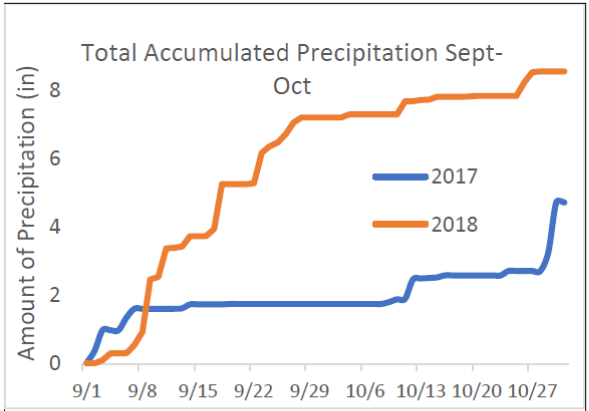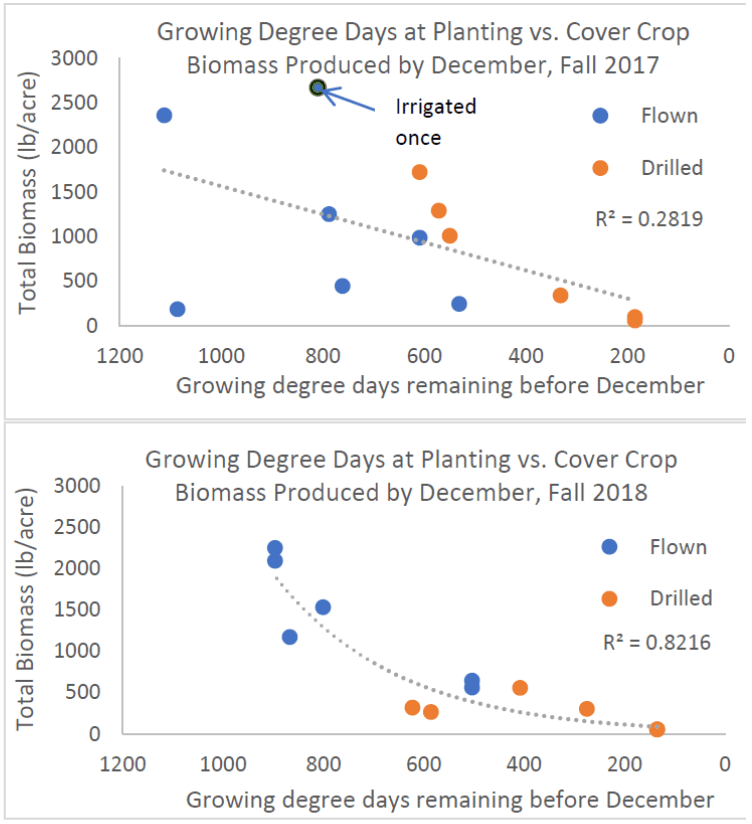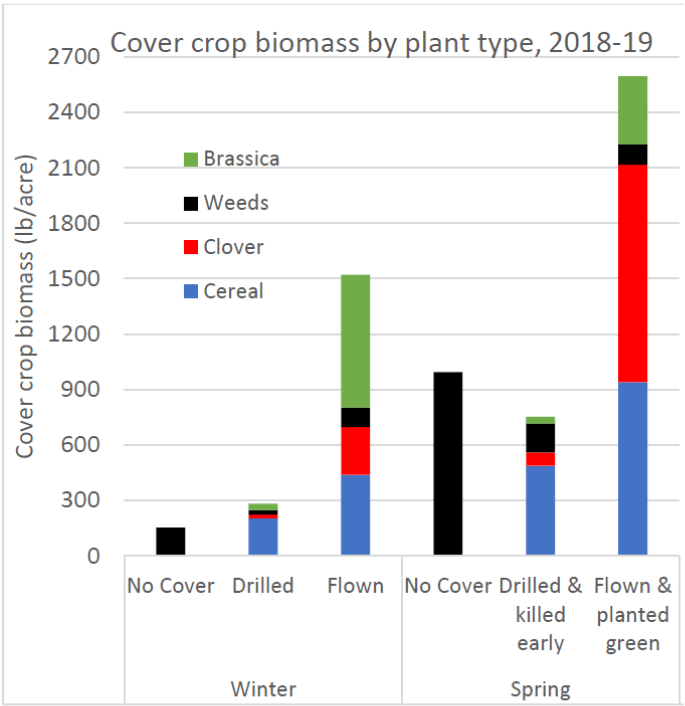Catherine Gaudlip2, Nathan Sedghi2, Rebecca Fox2, Leslie Sherman and Ray Weil1
1University of Maryland and 2Washington College
Thanks, in part, to the Maryland Agriculture Cost Share (MACS) incentive program, Maryland farmers have long led the nation in cover crop adoption. Over the past few years, many farmers have graduated from single-species to multiple-species cover crops that can increase biodiversity, soil health and resilience in the face of unpredictable weather extremes. Fine-tuning cover crop management as part of the whole farm system can enhance the benefits that cover crops provide to farmers and the Bay. For example, waiting until harvest is completed to plant cover crops in fall (hopefully by the last MACS deadline) and then terminating the covers as early as possible in spring is still a common approach that severely limits the benefits derived from multi-species cover crops. To perform effectively in preventing nitrogen leaching over the winter, cover crops need to get as early a start as possible so their roots will clean up the mobile nitrate from the deep soil layers where it is most susceptible to being lost to the Bay. Accomplishing this requires finding innovative ways to provide sufficient growing degree days (GDD) in fall. The same cover crop that prevented nitrogen leaching over the winter can pivot to providing nutrient cycling, weed suppression and soil and water conservation during the spring and summer if – and this is a big if – it is allowed to produce a large diverse biomass before it is terminated.

A common practice in Maryland is to drill a cover crop after harvest, which would typically be in October or November, and then kill it as early as mid-March to early April in the spring. We are conducting research that compares this common practice to a cover cropping season that is extended both in fall and in spring. There are many innovations that farmers are devising to extend the cover cropping season, but the most common and simplest are; 1) flying cover crop seed into standing crops weeks or even months ahead of harvest in the fall and 2) delaying cover crop termination right up to or even beyond cash crop planting in the spring using a technique known as “planting green.” Flying on cover crop seed may have the advantage of giving the covers a head start; however, it is more weather-dependent, can less reliably establish a good stand, and may produce less even stands than drilling after harvest. Planting green has been practiced successfully for almost a decade by a few innovative farmers in Maryland and elsewhere, but there is little research yet to document its performance. The strikingly different weather patterns of the past two years has allowed our research to assess how well these cover crop season-extending practices perform under a wide range of conditions.
Our study was conducted in collaboration with four farmers in Talbot and Kent Counties for two years. Seven fields (5 corn and 2 full season soybean) were used in fall 2017, and six fields (1 corn and 5 full season soybean) in fall 2018. Each field received two different cover crop planting treatments using a mix that included a brassica, legume, and cereal. The idea was to compare typical current cover crop management to an experimental extended-season cover crop. Therefore, cover crops were seeding either 1) by airplane into standing corn or soybeans between late August and the end of September, or 2) by drilling the seed after cash crop harvest (usually in October or November). In fall 2018, a third treatment, a no-cover control strip, was also included in each field. In spring the entire field was planted to a cash crop (corn or soybeans) on the same date, but the drilled cover crop was terminated at the farmer’s earliest convenience (2-4 weeks before cash crop planting), while the flown-on cover crop was planted green and terminated simultaneously with, or shortly after, cash crop planting.
Cover crop above-ground biomass (including the above ground portion of radish tuber) was harvested at random locations, separated by species, and weighed during the late fall, just before radishes were winter killed. Spring cover crop biomass was harvested just before herbicide application on the early killed treatment, and just before cash crop planting on the treatment that was planted green. Cover crop biomass was recorded by plant family, and the effects of planting/termination treatment was analyzed. We also analyzed the relationship between cover crop biomass and local weather conditions. Air temperature of 4 ᵒC (39 ᵒF) was used as the base in GDD calculations for the cover crop. The number of GDDs between cover crop planting and December 1st was determined for each treatment on every field, representing the number of growing degree days available to each cover crop. Cumulative daily rainfall for September and October was also analyzed to differentiate fall cover cropping conditions between the two years.
The amount of rainfall during September and October, when cover seeds were flown or drilled, differed greatly between 2017 and 2018. The fall of 2017 was hot and dry (Figure 1), with approximately 2” of rainfall for the entire month of September, and no autumn day having greater than 1” of rainfall until October 12th. In September and October of 2018 there were several rainfall events of greater than 1”, and there was no two week period without a daily rainfall of at least 0.5”. Unless irrigation is applied (a practice worth considering if available) the effectiveness of aerially seeding a cover crop is highly dependent on timely rainfall to germinate seeds that are broadcast without much seed-to-soil contact. On the other hand, excessively wet conditions can delay harvest operations and push cover crop drilling dates into November or beyond.
The contrast between fall 2017 and fall 2018 was dramatic. In 2017, harvest was on-time and some cover crops were drilled before the end of September, leading to only a two week difference, on average, between flown and drilled cover crops in our study. The flown cover crop stands were not very uniform and stand establishment was not always successful, likely due lack of rain after seeding causing late germination. In 2017, two fields were excluded from data collection because the flown cover crop failed to establish. The higher uniformity of the drilled cover crop resulted in a strong correlation between available growing degree days and total cover crop biomass (Figure 2, upper).

In 2018, by contrast, wet conditions led to timely germination and lush, fairly uniform stands on the flown cover crop treatments. However, the wet conditions delayed cash crop harvest, delaying and reducing the effectiveness of post-harvest cover crop drilling. The delays led to the drilled cover crop stand being a failure in one field and the time difference between flying-on and drilling cover crop seed was about 4 weeks, on average. In 2018, available growing degree days correlated closely with fall biomass achieved for flown-on cover crops, but the correlation was weak for drilled cover crops (Figure 2, lower).

While there were several individual fields with higher drilled than flown cover crop biomass in 2017, the overall average winter biomass did not differ between the two seeding methods. The cover crop biomass was not evenly distributed among the species planted. The majority of biomass in the drilled treatment came from cereals. Cereals, more than legumes and brassicas, germinate and grow well in the cooler conditions of late fall. The majority of fall 2017 biomass in the flown treatment was from brassicas (rapeseed, radish). The brassicas are very quick to germinate and grow aggressively in the warmer condition of early fall/late summer, crowding out the cereals, but apparently co-existing with the legumes. In the spring of 2018, the same pattern was observed. The drilled cover crop, which was also killed in early April, consisted almost entirely of cereals. Cereals were also made up about 60% of total biomass in the flown and planted green treatment, but there was much higher clover biomass in this treatment than in the drilled and killed early treatment (Figure 3). Cereals are good at reducing nutrient leaching, but also tend to tie up nutrients for the spring cash crop. In the wet fall of 2018, the flown biomass was substantially higher and more diverse (Figure 4). Brassicas dominated the flown biomass, but the clover biomass was almost as high as the cereals. In the drilled treatment, cereals provided almost all the biomass, but this was still lower than the cereal biomass in the flown treatment. In spring 2019, cereals still dominated the drilled and killed early treatment, but there were more weeds than either clover or brassicas. The flown and planted green cover crop biomass was approximately 45% clover. This high proportion of clover can be expected to eliminate nitrogen tie-up and may allow some reduction in fertilizer nitrogen application for the following cash crop. High weed biomass in the spring of the no cover treatments indicate that the cover crops in both management systems substantially suppressed weed growth.

We can draw some preliminary conclusions from these data. While drilling a cover crop stand resulted in greater uniformity in the dry year, this did not necessarily produce greater cover crop biomass. Waiting until after harvest to drill a mixed species cover crop reduced the relative and absolute amount of brassica and clover growth. A cover crop dominated by cereals in the fall can lead to nitrogen tie up in the spring. In the wet year, flying a cover crop early was substantially more effective than drilling a cover crop, leading to higher biomass produced and greater diversity in mixed stands. These observed benefits are increased by delaying kill time in the spring. While there’s always a possibility that a cover crop stand can fail, our data suggest that even in a dry fall when weather conditions favor drilling, flying a cover crop on before harvest can still be an effective practice, on average. In the extremely wet year, flying on the seed early was far more effective, on average, than drilling after harvest. While more site-years of data are needed, these data are encouraging for inter-seeding, especially for mixed-species cover crops.
Note: This research is generously supported by ShoreRivers, Inc. and the Maryland Soybean Board.
